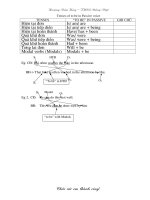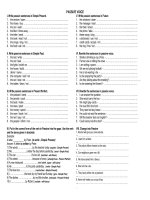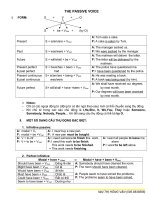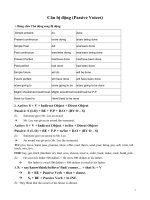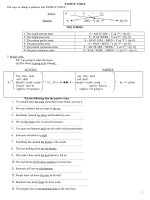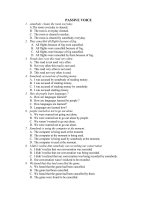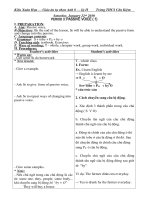- Trang chủ >>
- Y - Dược >>
- Sản phụ khoa
Making inferences
Bạn đang xem bản rút gọn của tài liệu. Xem và tải ngay bản đầy đủ của tài liệu tại đây (194.87 KB, 20 trang )
<span class='text_page_counter'>(1)</span><div class='page_container' data-page=1>
Making
</div>
<span class='text_page_counter'>(2)</span><div class='page_container' data-page=2>
Does it make sense to you?
(warm-up task)
“He put down $10 at the window.
The woman behind the window gave
$4. The person next to him gave
</div>
<span class='text_page_counter'>(3)</span><div class='page_container' data-page=3>
Possible inferences…
• Man & woman: <b>went on a date</b> to the movie
• Ticket: $3 each <b>man paid for both </b>
<b>himself and the woman</b> (total = $6).
• Man got the change back ($10-$3-$3=$4)
• The woman wanted to give him $3 for the
ticket but he declined.
</div>
<span class='text_page_counter'>(4)</span><div class='page_container' data-page=4>
What if we don’t know how
to make inferences?
• Tom: Are you free tonight?
• Mary: yes.
• Tom: I’ve two tickets for the concert.
• Mary: I see.
• Tom: So…
• Mary: What?
</div>
<span class='text_page_counter'>(5)</span><div class='page_container' data-page=5>
Decoding inferences
• “Are you free tonight”= want to ask
her to do something.
</div>
<span class='text_page_counter'>(6)</span><div class='page_container' data-page=6></div>
<span class='text_page_counter'>(7)</span><div class='page_container' data-page=7>
Making inferences
“When a reader <b>adds information that </b>
<b>he or she already knows to what is </b>
<b>stated</b>, the reader is making an
inference!” Beech (2005)
</div>
<span class='text_page_counter'>(8)</span><div class='page_container' data-page=8>
In simple words, making
inferences is…
</div>
<span class='text_page_counter'>(9)</span><div class='page_container' data-page=9></div>
<span class='text_page_counter'>(10)</span><div class='page_container' data-page=10>
How to begin with the students?
• 1) use an everyday occurrence to
demonstrate the idea of making inferences.
• 2) use a <b>short piece of text</b> and ask the
students to annotate as many inferences as
they can.
• 3) can use bumper stickers to write the
internal text that comes from the external
text
</div>
<span class='text_page_counter'>(11)</span><div class='page_container' data-page=11>
Non-fiction text
<b> </b>
<b>Text type: </b>
<b>News report</b>
</div>
<span class='text_page_counter'>(12)</span><div class='page_container' data-page=12>
Activity 2
Inferring the meaning of
unknown words
<b> 1st paragraph (example):</b>
A wealthy local businessman was found
dead yesterday at his home on The Pea
k. Police believe that Albert
</div>
<span class='text_page_counter'>(13)</span><div class='page_container' data-page=13>
Activity 2
Inferring the meaning of
unknown words
<b> 1st paragraph (example):</b>
A wealthy local businessman was found
dead yesterday at his home on The Pea
k. Police believe that Albert
Sung, a jewellery shop
owner, was <b>murdered</b>.
<b>died because of money?</b>
<b>discovered later, rather strange!</b>
<b>involving police </b>
<b>perhaps he didn’t</b>
<b>die naturally</b>
</div>
<span class='text_page_counter'>(14)</span><div class='page_container' data-page=14>
“Um…let me think…in this paragraph I can see that
the dead man was wealthy, that means he had a lot
of money…but he died suddenly, and that attracte
d the police to come…seems a bit strange, so I gue
ss he didn’t die naturally. At the end I spot the us
e of passive voice, that means he didn’t cause the
death himself, or die from an illness. Perhaps... he
was killed by someone.”
</div>
<span class='text_page_counter'>(15)</span><div class='page_container' data-page=15>
Remember, when using the
<b>think aloud approach…</b>
</div>
<span class='text_page_counter'>(16)</span><div class='page_container' data-page=16>
Guess result
Murdered
=
</div>
<span class='text_page_counter'>(17)</span><div class='page_container' data-page=17>
Useful text types for
teaching inferences
• 1) <b>editorials</b> (e.g. by comparing the headli
nes of 2 newspapers reporting the same n
ews)
• 2) <b>documentary</b> (e.g. 60 mins. plus)
looking for the director’s point of view
</div>
<span class='text_page_counter'>(18)</span><div class='page_container' data-page=18></div>
<span class='text_page_counter'>(19)</span><div class='page_container' data-page=19>
Using
logic problems
can
help students develop their
ability to make inferences
<b>New Shoes…</b>
One day, two mothers and two daughters
went shopping for shoes. Their shopping
</div>
<span class='text_page_counter'>(20)</span><div class='page_container' data-page=20>
Answer
Only three people went shopping: a
grandmother, a mother, and a daughter
— but remember that the mother was
the grandmother's daughter!
</div>
<!--links-->

